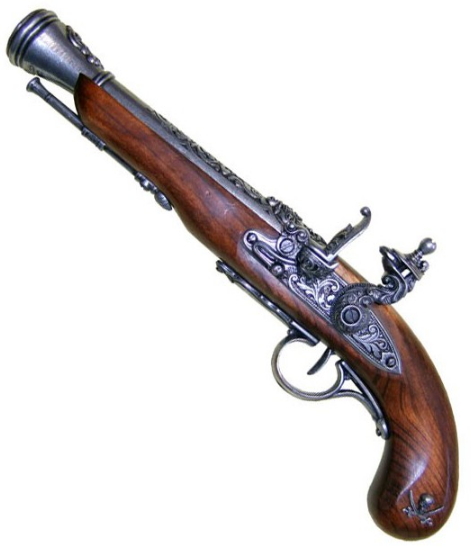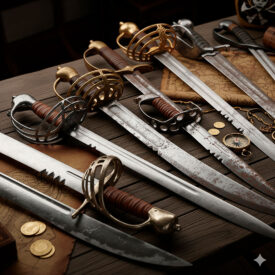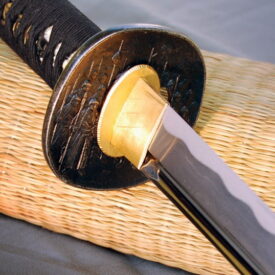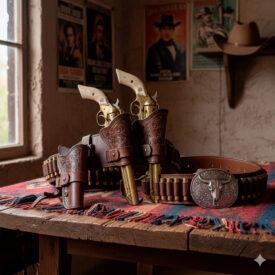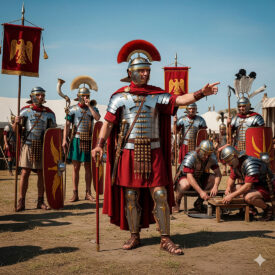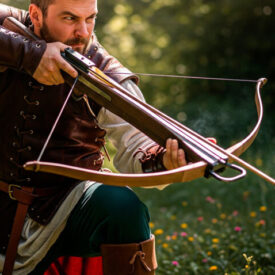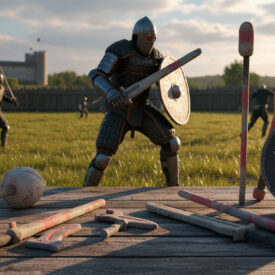What made pirate pistols the favorite weapon aboard? Their size, their power at close range, and their operational simplicity. In this definitive guide to pirate pistols, we explore their origin, types of mechanisms, real combat tactics, replica parts and maintenance, with clear comparisons and buying tips to choose the perfect replica.
Piracy, Trade, and the Role of Onboard Pistols
Piracy emerged alongside maritime trade. From the earliest routes, there were always those who tried to seize goods by force on the high seas. Although records exist from Antiquity, the rise of piracy occurred between the 16th and 17th centuries, driven by the intense exchange between the Kingdom of Spain and its colonies. In this scenario, pirate pistols became a key weapon for combat in confined spaces.
Light, maneuverable, and designed for face-to-face combat, boarding pistols offered a decisive shot at close range before transitioning to the saber or dagger. Their design responded to a need: to strike quickly and within a few meters, on slippery decks, amidst smoke, noise, and chaos.
How they worked: muzzle-loading and a single shot
Pirate pistols from the 16th to 18th centuries were single-shot and muzzle-loading. After each shot, they had to be reloaded with gunpowder, a projectile, and a cloth (or paper) wad to compress the charge, pushed with a ramrod. In a boarding action, time to reload was scarce, which is why many pirates carried several pistols ready to fire, in addition to bladed weapons.
Typical reloading steps
- Pour the measured gunpowder into the barrel.
- Insert the ball and the cloth/paper wad to maintain compression.
- Push with the ramrod to the bottom.
- Prime the pan (for flintlock) or prepare the corresponding mechanism.
- Secure the lock and aim at close range.
From Powder to Flintlock: Rapid Evolution in 3 Acts
The origins of firearms date back to China, where gunpowder was already known around the 9th century. Its arrival in Europe, mediated by the Arab world, spurred the first developments in the 14th century. In the naval sphere of the 16th-18th centuries, three mechanisms stand out:
| Mechanism | Predominant Period | How it fires | Advantages | Limitations | Typical use in piracy |
|---|---|---|---|---|---|
| Wheelock | 16th-17th Centuries | A steel wheel rotates, rubs a pyrite, and generates sparks. | More reliable than matchlock in windy weather; controlled ignition. | Complex and expensive mechanism; delicate maintenance. | Officer’s pistols or valuable loot; not as widespread. |
| Flintlock (flintlock mechanism) | 17th-18th Centuries | The flint strikes the frizzen, sparks jump to the priming powder. | Robust, relatively cheap, standard of its time. | Sensitive to humidity; requires good flint and dry priming powder. | The favorite in boardings due to cost-reliability. |
| Percussion | Late 18th-19th Centuries | Fulminant cap struck by hammer ignites the charge. | More reliable in humidity, consistent ignition. | Later than the classic pirate heyday; transition to revolvers. | Historical replicas and later use in seafaring. |
The popularization of the flintlock mechanism in the 18th century coincided with the end of the peak period of piracy, but its benefits over previous mechanisms established these pistols as the standard for boarding.
Real Tactics Onboard: From Close Range to Blade Weapon
In naval combat, time and space were minimal. This is how pirate pistols were integrated into the attack sequence:
- Approach and initial fire: firing at very close range (3-10 meters) to break defenses and sow chaos.
- Multiple discharge: carrying 2-4 pistols to avoid immediate reloading.
- Quick transition: switching to saber, axe, or dagger after the first shots.
- Visibility and weather: dense smoke, wet deck, and wind affected both aiming and ignition.
Due to their power at close range, striking an opponent once was enough to neutralize them. Fine precision mattered less than the ability to fire quickly and switch weapons.
Parts and anatomy of a pirate pistol
Understanding its components helps you value a quality replica:
- Barrel: usually smoothbore and short for quick handling.
- Stock and grip: hard wood; frequent “fishtail” shape.
- Lock: the mechanism (wheelock, flintlock, or percussion) that ignites the gunpowder.
- Pan and frizzen: present in flintlock; critical for ignition.
- Trigger and trigger guard: firing control and protection.
- Ramrod: essential for loading.
- Fittings and embellishments: brass, steel, or alloys, sometimes decorated.
Myths and realities about pirate pistols
- They were not extremely accurate: the short, smoothbore barrel favored point-blank shooting.
- They were not reloaded “in seconds” during a boarding: that’s why several were carried.
- Humidity was their great enemy: protecting powder and primer was essential.
- Highly ornate designs existed, but they were more typical of officers or valuable loot than widespread use.
Preservation and care of pirate pistol replicas
If you collect or decorate with pirate pistol replicas, care for them to preserve their appearance and function (if they are functional muzzleloaders):
- Clean metal with a dry or lightly oiled cloth to prevent rust.
- Wood: periodic hydration with appropriate products; avoid direct sunlight.
- Storage: breathable cover and dry environment.
- Mechanisms: do not overuse “dry firing” on flintlock/percussion mechanisms; check screws.
- If firing a muzzleloader: follow safety protocols and barrel cleaning after each use.
Legal Framework and Basic Safety
Decorative replicas are usually deactivated; functional ones (muzzleloaders) are governed by specific regulations depending on the country. Verify requirements for possession, transport, and use in historical reenactment spaces. Never handle gunpowder without training and always follow safety measures.
Buyer’s Guide for Pirate Pistol Replicas
What to look for before buying
- Intended use: decoration, historical reenactment, collection, or functional muzzleloader.
- Materials: hardwoods (walnut, beech) and treated metals; avoid visible plastics in key parts.
- Finishes: realistic aging vs. polished; engravings and fittings.
- Mechanism: decorative (non-functional), operational flintlock, or percussion.
- Ergonomics: balanced weight, comfortable grip.
- Dimensions: short barrel for boarding style; long versions for officers.
- Warranty and after-sales service: spare ramrods, springs, flints.
Quick comparison of replicas by intent
| Intent | Mechanism Type | Recommended Material | Finish | Value for money | Comment |
|---|---|---|---|---|---|
| Basic Decoration | Decorative (non-firing) | Wood + alloy | Light aging | High | Ideal for setting the mood in studies and themed rooms. |
| Historical Reenactment | Functional Flintlock | Hardwood + steel | Realistic aging | Medium-High | Look for flint reliability and replacement flints. |
| Premium Collection | Flintlock or Wheelock | Walnut + brass/steel | Engravings and fittings | Variable | Values historical accuracy and craftsmanship. |
| Muzzleloading Shooting | Percussion | Carbon steel | Functional | Medium | More reliable in humidity, demanding maintenance. |
Quick Checklist
- Is the lock adjustment solid and does it fire without play?
- Is the wood well finished, without splinters or thick varnish?
- Do the fittings fit without gaps and with correct screws?
- Does the manufacturer offer spare parts (springs, flints, ramrods)?
- Does it come with certification as a decorative replica or documentation if functional?
Tips for displaying and preserving
- Wall mounts that do not press on the barrel.
- Avoid humidity and sudden temperature changes.
- Microfiber cloth to remove dust and fingerprints.
- If using flint: check and replace when it sparks little.
Common mistakes when choosing
- Prioritizing only aesthetics and forgetting ergonomics.
- Ignoring compatibility of spare parts (ramrods, springs).
- Not considering the climate if you plan to use it outdoors.
- Buying without checking return policies and warranty.
Additional Historical Context for Better Choice
Knowing which pirate pistols were most common by region and period helps you add coherence to your collection. In 18th-century Caribbean routes, the flintlock mechanism predominated; in earlier phases, the wheelock was a status symbol. Replicas that imitate these variants, with correct dimensions and fittings, enhance decorative and historical value.
Benefits of investing in well-built replicas
- Durability and authentic feel to the touch.
- Details that withstand the scrutiny of enthusiasts and experts.
- Greater value stability over time.
How to integrate pirate pistols into thematic decor
- Combine them with nautical maps, sextants, and marine ropes.
- Display in duos or trios on dark wood to create visual rhythm.
- Warm lighting to highlight aged metals.
Keys to visual authenticity
- Credible patinas: brass and steel tones without excessive shine.
- Period tools (ramrod, flint) visible in the replica.
- Historical proportions of the barrel and stock.
A note on maintenance if functional
After any muzzleloading shot, clean immediately to prevent corrosion: warm water in the barrel, complete drying, thin oil, and mechanism check. Black powder leaves hygroscopic residues; prevention is your best ally.
The essential you should remember
- Pirate pistols reinvented onboard combat: single shot, close impact, and transition to bladed weapon.
- Flintlock was the 18th-century standard; wheelock, the more complex predecessor; percussion, the transition to greater reliability.
- A good replica balances historical fidelity, materials, and manageable maintenance.
If you seek to learn, collect, or decorate with criteria, understanding the history and operation will allow you to choose better and enjoy each piece more.
VIEW MORE PIRATE PISTOL REPLICAS | VIEW MORE FIREARMS REPLICAS



